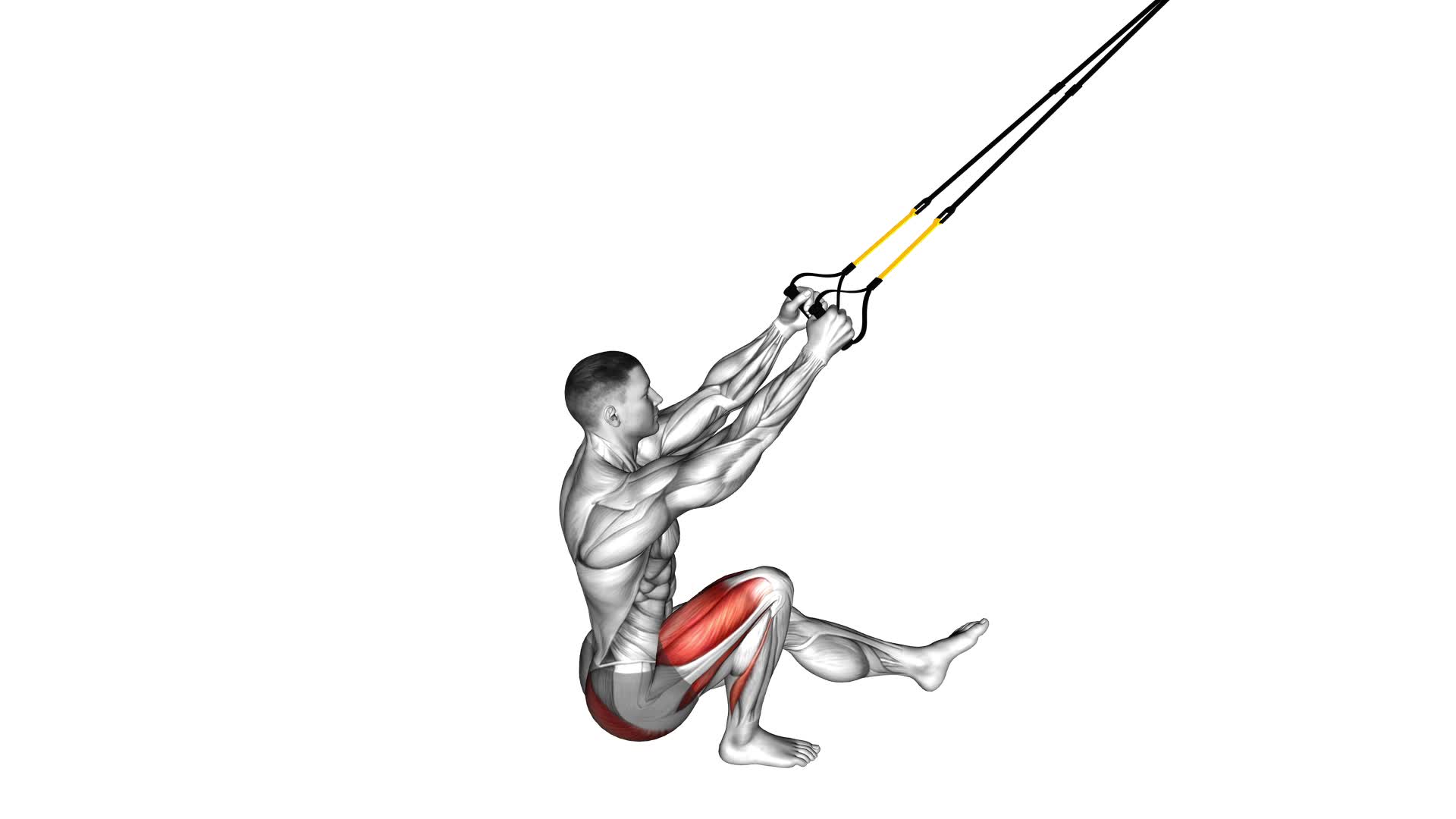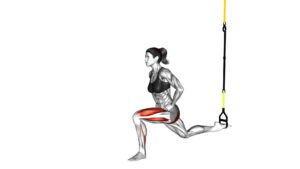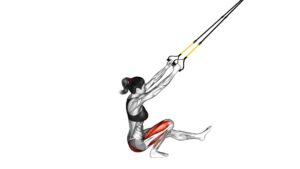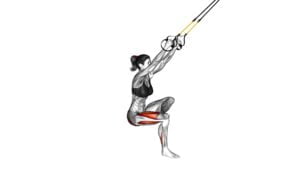Suspender Single Leg Squat (male) – Video Exercise Guide & Tips

Looking to strengthen your legs and improve your balance? The Suspender Single Leg Squat is the exercise for you!
Watch This Exercise Video
In this video exercise guide, we'll show you the proper form and technique to perform this challenging move.
You'll also learn common mistakes to avoid and tips for maximizing your results.
So grab your suspenders and get ready to squat like never before!
Key Takeaways
- The Suspender Single Leg Squat strengthens leg muscles and improves balance.
- It is effective for injury prevention and activates the quadriceps, hamstrings, and glutes.
- This exercise enhances overall athletic performance and should be performed with proper form and technique.
- Common mistakes to avoid include lack of balance and stability, improper breathing technique, leaning forward excessively, and not keeping the supporting foot firmly planted.
Benefits of the Suspender Single Leg Squat
One benefit of the Suspender Single Leg Squat is that it strengthens your leg muscles and improves balance. This exercise is highly effective for injury prevention and muscle activation.
By performing the Suspender Single Leg Squat, you're engaging multiple muscle groups in your legs, including your quadriceps, hamstrings, and glutes. Strengthening these muscles not only helps to prevent injuries, but also improves your overall athletic performance.
Additionally, this exercise requires a great deal of balance and stability, which helps to improve your proprioception and coordination. As you lower yourself down into the squat position, your muscles are activated to support your body weight and maintain proper form.
This activation not only helps to build strength, but also improves joint stability and reduces the risk of injury. By regularly incorporating the Suspender Single Leg Squat into your workout routine, you can reap the benefits of stronger leg muscles, improved balance, and reduced risk of injury.
Proper Form and Technique for the Exercise
To perform the Suspender Single Leg Squat with proper form and technique, maintain a stable and balanced position while engaging your leg muscles. Start by standing with your feet hip-width apart and your arms extended in front of you. Place one foot in the suspension strap, keeping your knee slightly bent. Slowly lower your body by bending your standing leg, while simultaneously extending the suspended leg out in front of you. Keep your torso upright and your core engaged throughout the movement.
As you lower yourself, ensure that your knee stays aligned with your toes and doesn't collapse inward. Exhale as you push through your heel to return to the starting position, and inhale as you lower yourself down. Focus on controlling the movement and maintaining proper form throughout the exercise.
Now that you understand the proper form and technique for the Suspender Single Leg Squat, let's discuss some common mistakes to avoid during the exercise.
Common Mistakes to Avoid During the Exercise
To perform the Suspender Single Leg Squat correctly, it's important to maintain proper form throughout the exercise. One common mistake to avoid isn't keeping your balance and stability, which can lead to injury.
Additionally, pay attention to your breathing technique, as improper breathing can affect your performance and form.
Proper Form Importance
To maintain proper form during the Suspender Single Leg Squat exercise, it's crucial to avoid common mistakes. This not only ensures that you get the maximum benefits from the exercise but also helps in preventing injuries. Here are some important points to keep in mind:
- Keep your chest up and shoulders back to maintain a straight posture.
- Engage your core muscles to stabilize your body throughout the movement.
- As you lower down into the squat, make sure your knee stays in line with your toes.
- Avoid leaning forward excessively, as this can put unnecessary strain on your lower back.
- Keep your supporting foot firmly planted on the ground to maintain balance and stability.
- Finally, remember to breathe properly, inhaling as you lower down and exhaling as you push back up.
Following these proper form techniques will ensure a safe and effective Suspender Single Leg Squat exercise.
Balance and Stability
Maintain balance and stability during the Suspender Single Leg Squat exercise by avoiding common mistakes.
Balance training and stability exercises are crucial for this exercise to be effective and safe.
One common mistake to avoid is shifting your weight too far forward or backward. This can throw off your balance and make it difficult to perform the exercise correctly. Instead, focus on keeping your weight centered and evenly distributed on your standing leg.
Another mistake to watch out for is allowing your knee to collapse inward. This can put unnecessary strain on your joints and decrease stability. To prevent this, engage your glutes and outer thigh muscles to keep your knee aligned with your toes.
Breathing Technique Tips
To optimize your performance and avoid common mistakes, focus on proper breathing technique during the Suspender Single Leg Squat exercise. Proper breathing techniques are essential for maximizing muscle activation and maintaining stability throughout the movement. Here are some tips to help you improve your breathing technique:
- Breathe in deeply through your nose before starting the squat.
- As you lower your body, exhale slowly through your mouth to engage your core and stabilize your body.
- Inhale again at the bottom of the squat to prepare for the ascent.
- Exhale forcefully through your mouth as you push through your heel to return to the starting position.
By following these breathing techniques, you'll enhance your muscle activation and ensure proper form during the Suspender Single Leg Squat exercise.
Now, let's explore a variation of this exercise by adding weights to increase intensity.
Variation: Adding Weights to Increase Intensity
Adding weights to the Suspender Single Leg Squat is a great way to challenge your muscles and take your workout to the next level. By incorporating weights, you can increase the resistance and target your lower body muscles even more effectively. There are several ways to modify the exercise with weights to create advanced variations.
One option is to hold a dumbbell in each hand while performing the single leg squat. Start with a lighter weight and gradually increase as you become more comfortable with the exercise.
Another variation is to use a weighted vest or a weighted backpack. This allows you to distribute the weight evenly and adds an extra challenge to your balance and stability.
For a more advanced variation, you can also try using a barbell. Hold the barbell across your upper back, using an overhand grip, and perform the single leg squat. This variation requires more strength and stability, so it's important to start with lighter weights and focus on maintaining proper form.
Adding weights to the Suspender Single Leg Squat is an effective way to increase the intensity and challenge your muscles. Remember to start with lighter weights and gradually increase as you become more comfortable and confident with the exercise. Always prioritize proper form and listen to your body to avoid injury.
Tips for Maximizing Your Results With the Suspender Single Leg Squat
To maximize your results with the Suspender Single Leg Squat, it's important to focus on proper form techniques.
Make sure to engage your core, keep your back straight, and lower yourself down slowly and controlled.
Additionally, if you're a beginner, you can modify the exercise by using a support or performing the squat with both legs until you build enough strength and balance to do it on one leg.
Proper Form Techniques
To maximize your results with the Suspender Single Leg Squat, it's important that you focus on proper form techniques. By improving your balance and increasing your strength, you can achieve better results from this exercise. Here are some tips to help you perfect your form:
- Stance: Stand with your feet hip-width apart and your hands on your hips.
- Leg Position: Extend one leg forward, keeping it slightly off the ground.
- Squat: Lower your body down by bending your standing leg, while keeping your back straight and chest lifted.
- Depth: Aim to squat until your thigh is parallel to the ground.
- Control: Slowly rise back up to the starting position, using your leg muscles to control the movement.
- Repeat: Complete the desired number of reps on one leg before switching to the other.
Remember to maintain proper form throughout the exercise to maximize your results and minimize the risk of injury.
Effective Modifications for Beginners
For beginners looking to maximize their results with the Suspender Single Leg Squat, there are effective modifications that can be implemented. These modifications, also known as progressions and regressions, can help you gradually build strength and stability while performing the exercise.
If you're just starting out, you can begin with a supported version of the exercise by using a chair or wall for balance. As you become more comfortable and gain strength, you can progress to performing the exercise without any support. Additionally, you can modify the depth of the squat by adjusting the height of the support.
Remember to listen to your body and start with a modification that suits your current fitness level. By gradually progressing and challenging yourself, you can maximize your results with the Suspender Single Leg Squat.
Safety Precautions and Modifications for Beginners
Before attempting the Suspender Single Leg Squat, it's important for beginners to take certain safety precautions and make modifications to suit their fitness level. Here are some tips to help you stay safe and get the most out of this exercise:
- Safety Precautions:
- Warm up your muscles before starting the exercise to prevent injury.
- Maintain proper form throughout the movement to avoid strain on your joints.
- Start with a light load or no load at all and gradually increase the weight as you become more comfortable with the exercise.
- Listen to your body and stop if you experience any pain or discomfort.
- If you have any pre-existing medical conditions or injuries, consult with a healthcare professional before attempting this exercise.
- Beginner Modifications:
- Start by using a suspension trainer at a higher position to reduce the difficulty and intensity of the exercise.
- Use a support or hold onto a stable object, like a wall or railing, for balance until you build up enough strength and stability.
- Perform the movement with both feet on the ground instead of using only one leg to make it easier.
- If balance is a challenge, try performing the exercise with a chair or bench behind you to lightly tap your glutes on for support.
Frequently Asked Questions
How Long Should I Hold the Squat Position During the Suspender Single Leg Squat Exercise?
When doing the suspender single leg squat exercise, it's important to focus on proper form. One key aspect is how long you hold the squat position. To maximize the exercise's benefits, aim to hold the squat for about 2-3 seconds before returning to the starting position.
This helps engage your muscles and improve stability. Avoid rushing through the movement or holding the squat for too long, as it can compromise your form and increase the risk of injury.
Can I Perform the Suspender Single Leg Squat Exercise if I Have Knee or Ankle Injuries?
If you have injured knees or ankles, it's important to be cautious when performing the suspender single leg squat exercise.
It's always best to consult with a healthcare professional before attempting any exercise. They can provide guidance on modified variations that are safe for your specific condition.
Is It Better to Perform the Suspender Single Leg Squat Exercise on a Hard Surface or on a Mat?
To perform the suspender single leg squat exercise, you have the option of doing it on a hard surface or on a mat. Both options have their benefits.
When done on a hard surface, your stability and balance will be challenged, making the exercise more intense.
On the other hand, doing it on a mat can provide some cushioning and reduce impact on your joints.
Choose the option that feels more comfortable and suits your fitness level.
Are There Any Specific Breathing Techniques I Should Follow While Performing the Suspender Single Leg Squat Exercise?
When performing the suspender single leg squat exercise, it's important to focus on your breathing. Take a deep breath in before you lower down into the squat, and exhale as you push yourself back up. This helps to stabilize your core and maintain proper form. Remember to breathe consistently throughout the exercise to ensure you're getting enough oxygen to your muscles.
The benefits of this exercise include improved balance, strength, and stability in your legs and core.
Can I Incorporate the Suspender Single Leg Squat Exercise Into My Regular Leg Day Workout Routine?
Yes, you can definitely incorporate the suspender single leg squat exercise into your regular leg day workout routine.
It's a great way to challenge your leg muscles and improve your balance and stability.
By adding this exercise to your routine, you can target your legs in a different way and reap the benefits of single leg exercises.
Don't forget to incorporate other leg exercises as well to ensure a well-rounded workout.
Conclusion
In conclusion, the suspender single leg squat is a great exercise for targeting the lower body muscles and improving balance and stability.
By maintaining proper form and avoiding common mistakes, you can maximize the benefits of this exercise.
Adding weights can increase the intensity for a greater challenge.
Remember to always prioritize safety and modify the exercise if you're a beginner.
Incorporate the suspender single leg squat into your fitness routine to see improvements in strength and overall fitness.

Author
Years ago, the spark of my life’s passion ignited in my mind the moment I stepped into the local gym for the first time. The inaugural bead of perspiration, the initial endeavor, the very first surge of endorphins, and a sense of pride that washed over me post-workout marked the beginning of my deep-seated interest in strength sports, fitness, and sports nutrition. This very curiosity blossomed rapidly into a profound fascination, propelling me to earn a Master’s degree in Physical Education from the Academy of Physical Education in Krakow, followed by a Sports Manager diploma from the Jagiellonian University. My journey of growth led me to gain more specialized qualifications, such as being a certified personal trainer with a focus on sports dietetics, a lifeguard, and an instructor for wellness and corrective gymnastics. Theoretical knowledge paired seamlessly with practical experience, reinforcing my belief that the transformation of individuals under my guidance was also a reflection of my personal growth. This belief holds true even today. Each day, I strive to push the boundaries and explore new realms. These realms gently elevate me to greater heights. The unique combination of passion for my field and the continuous quest for growth fuels my drive to break new ground.



